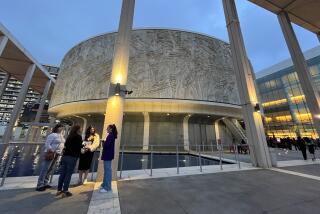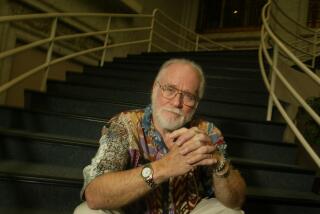One more act for the phantom of the playhouse?
The Pasadena Playhouse is back. After shutting its doors in February because of financial problems, the theater reopened Oct. 12 with the one-man play “FDR” starring Ed Asner.
But is the building’s most enduring protagonist back as well?
Some say Gilmor Brown, the charismatic founder of the playhouse, has been haunting the theater and adjacent office building since his death in 1960.
Brown’s ghost has never been seen, but he’s made his presence known in other ways, such as moving things around, stomping about and taking control of the elevator, according to Pasadena Playhouse archivist Ellen Bailey, who has been associated with the theater since the 1940s.
His intent has never been to scare or disrupt, said Bailey. “He’s a helpful, friendly ghost. When he was alive, he wanted things a certain way, and he still does.”
But the question is now: Is Gilmor’s ghost still there? Or did he get lonely while the theater was empty and depart for happier haunting grounds?
Before his death, Brown poured his heart, soul and talent into the theater for over 30 years. He was born in North Dakota in 1886 and as a young man created an acting troupe called The Gilmor Brown Players.
In 1917, he established the Community Playhouse Assn. of Pasadena. In 1925, he founded and became the artistic director of the newly built Pasadena Community Playhouse, which was designed in the Spanish colonial revival style by noted Pasadena architect Elmer Grey.
The theater quickly rose to national prominence with the Southern California premieres of plays by William Saroyan, Noel Coward and Tennessee Williams, as well as the world premiere of Eugene O’Neill’s “Lazarus Laughed.”
In 1928, Brown established a school of theater arts. In 1937, the playhouse was declared the State Theater of California after it became the first American theater to perform the entire Shakespeare canon.
Many major talents passed through the school and theater, including Gene Hackman, Dustin Hoffman, William Holden, Raymond Burr and Sally Struthers. Brown remained at the helm of the playhouse until the late 1950s.
There are many tales of Brown’s afterlife appearances, such as when in the late 1980s he was said to have lent a hand to a theater alumnus who was working on a set late at night. As the graduate was carrying a heavy set piece down the hall, he felt the other end being lifted up and carried, according to Bailey. Having heard stories about Gilmor’s ghost, the man was spooked at first, and he ran out of the building. But eventually he figured that if Gilmor was going to help him, let him. “He went back with renewed energy and finished the set,” Bailey said.
Brown, a perfectionist, would often keep actors at dress rehearsals into the wee hours until he was satisfied with their performances. According to Bailey, he would sit in the audience with his cat, and if the cat turned his back to the stage, that was Brown’s cue that a scene needed to be tweaked.
And though both he and the cat are long gone, Brown has continued to make his disapproval clearly known, Bailey said. Once during a dress rehearsal, an overhead light crashed onto the stage. “We all knew it was Gilmor,” she said. “The director said, ‘OK, Gilmor, I’ll fix that scene.’”
Another trick that Bailey said Brown used to play: fiddling with the lights in the control booth.
During intermission the technicians would lock the booth and take a break; when they returned, the settings on the lights would be changed.
And over the years, if anyone ever heard footsteps when no one was around, or a piece of paper or a prop mysteriously disappeared or got moved, they’d blame it on Brown, Bailey said.
Up until about a year ago, when the playhouse switched office space, Brown also regularly “visited” his former office on the third floor. Frequently, the elevator would stop at the floor even though no one pushed the button, said Bailey. The door would open and close, as if Brown himself were getting off.
Not everyone associated with the theater believes it’s haunted, however. Sheldon Epps, the artistic director of the playhouse for the last 13 years, said that although he feels “a spiritual and artistic connection” with Brown, he’s never picked up on a supernatural vibe.
But those who do believe are wondering: Where is Gilmor’s ghost now?
Tom Ogden, a local ghost lore expert and the author of “Haunted Theaters,” thinks Brown’s attachment to the theater is so strong that a short closure wouldn’t scare him away. He points out that the Pasadena Playhouse closed down once before because of financial problems for a much longer time, from 1969 to 1986, and says Brown’s ghost stuck around then.
“My guess is it won’t be long before we start hearing about new hauntings at the playhouse,” he said.
In fact, such a “haunting” may have already taken place.
According to Bailey, when a production crew was in the playhouse readying the set of “FDR,” a table tipped over and a drawer popped open. And what fell out? Photos of Gilmor Brown.
And that, she said, “tells me that he’s still here.”
More to Read
Start your day right
Sign up for Essential California for news, features and recommendations from the L.A. Times and beyond in your inbox six days a week.
You may occasionally receive promotional content from the Los Angeles Times.






